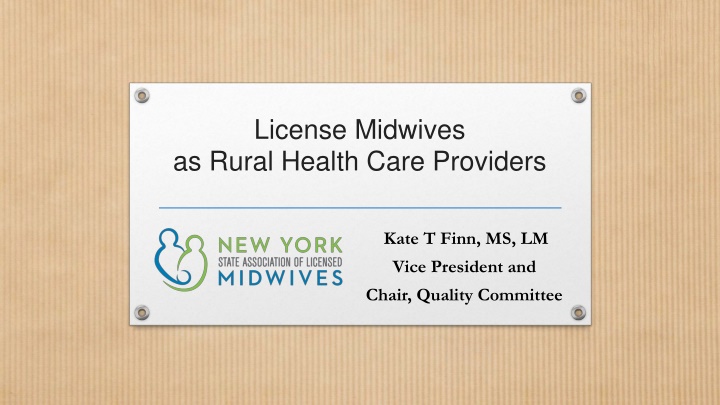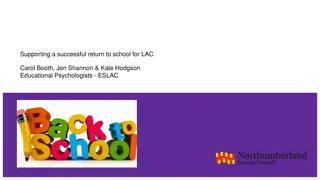
Licensed Midwives in Rural Health Care Providers Presentation
Explore the role of licensed midwives as rural health care providers in New York State, covering their professional education, scope of practice, collaborative care models, cost-effectiveness, and high-value care delivery. Discover key demographics, regulatory aspects, and primary care responsibilities of licensed midwives in the state.
Download Presentation

Please find below an Image/Link to download the presentation.
The content on the website is provided AS IS for your information and personal use only. It may not be sold, licensed, or shared on other websites without obtaining consent from the author. If you encounter any issues during the download, it is possible that the publisher has removed the file from their server.
You are allowed to download the files provided on this website for personal or commercial use, subject to the condition that they are used lawfully. All files are the property of their respective owners.
The content on the website is provided AS IS for your information and personal use only. It may not be sold, licensed, or shared on other websites without obtaining consent from the author.
E N D
Presentation Transcript
License Midwives as Rural Health Care Providers Kate T Finn, MS, LM Vice President and Chair, Quality Committee
No Conflicts of Interest to Disclose Kate T Finn, MS, LM Vice President, New York State Association of Licensed Midwives (NYSALM) Chair, Quality Committee and Home Birth Integration Initiative Delegate, National Home Birth Summit and Collaboration Task Force Private Practice Licensed Midwife for 30 years Attending births in rural hospital, birth center and homes
Presentation Overview Overview of Midwifery in New York State Professional Education and Licensure Scope of Practice, Midwifery Model of Care Collaborative Care with Specialty Providers Cost Effectiveness Midwifery in Rural Health Context System Barriers to Midwifery Practice Midwives Deliver High-Value Care
Regulated by Board of Midwifery Masters-level education for licensure National certification by American Midwifery Certification Board (AMCB) Identical practice status and scope for Certified Nurse Midwives (CNMs) and Certified Midwives (CMs) Full scope practice Prescriptive privileges Practice in all care settings Medicaid and private insurance Malpractice insurance New York
Midwifery Demographics in NY New York has 1011 Licensed Midwives Vaginal deliveries in NY 10.6 % of Total NY Births in 2015 Medicaid 53% Statewide Midwives Obstetricians ~ 400 midwifery practice sites Family doctors ~103 hospitals ~2 free-standing birth centers Physician Assistants 1% Total NY Births in home setting
Licensed Midwives in Primary Care Annual exams Reproductive health visits Problem visits Writing prescriptions Counseling Patient education Primary Clinical Responsibility identified by CNM/CMs 53.3% reproductive care 33.1% primary care Fullerton J, Schuiling K, Sipe TA. Findings from the Analysis of the American College of Nurse- Midwives Membership Surveys: 2006 2008. Journal of Midwifery & Women s Health 2010; 55: 299-307.
Midwives Provide High-Value Care Within the Quality Framework Institute of Healthcare Improvement: Triple Aims Improving experience of care for the individual and family Improving health outcomes Lowering health care costs Institute of Medicine: Quality Domains of Healthcare Safe Effective Patient-centered Timely Efficient Equitable
MAXIMIZING MIDWIFERY to Achieve High-Value Maternity Care in New York Choices in Childbirth, 2018; Photo Credit: The Business of Being Born
MIDWIFERY MODEL OF CARE Woman- and family-centered, individualized care Evidence-based practices Shared decision-making and respectful treatment A preventative and comprehensive view of health Relationship-based care Meeting the needs of vulnerable populations A collaborative health care team model Photo Credit: Mario Cassase
Hallmarks of Midwifery Care Evidence for Safe Practice -- ACOG Committee Opinions #687 (2017), #684 (2017), #658 (2016), Safe Prevention of Primary CS (2016) Individualization of care One-on-one care Active labor starts at 6 cm Intermittent auscultation of FHT Drug-free pain relief measures Intact amniotic membranes Expectant management of term ROM Oral intake Unrestricted and upright positions Rest and spontaneous pushing Skin-to-skin contact Physiologic cord clamping Immediate breastfeeding support Safely reduce primary cesareans
Team-Based Care Midwives are independent providers Midwives initiate collaborative care with specialty providers when indicated by the patient s condition
BENEFITS OF MIDWIFERY MODEL Breastfeeding initiation Positive experience Patient satisfaction Sense of control and confidence Vaginal birth after cesarean Cost savings for care Cesarean Section Episiotomy Serious Lacerations Use of Pain Meds Epidural/Spinal analgesia Continuous Electronic Fetal Monitoring Vacuum/Forceps Extraction Induction of Labor Augmentation of Labor Intensive Care Admission of Newborn LESS LIKELY MORE LIKELY LESS OR SIMILARLY LIKELY
COST EFFECTIVENESS Estimated Annual Cost Savings by Reducing Cesarean Rates to 1995 Level of 22.5 % of NYS Total Births o Avoid unnecessary and non- beneficial interventions o Fewer complications from overuse of medical interventions o Reducing primary and repeat cesareans o Increasing breastfeeding $61 Million Saved by Medicaid
Disparities in Rural Maternity Care ACOG. Health Disparities in Rural Women, Committee Opinion #586, 2014 Enter pregnancy with poorer health status: heart disease, mental illness, cervical cancer, cigarette smoking, alcohol/opioid dependency, obesity Lower income, lack health insurance or use Medicaid, travel longer distances Later entry to prenatal care Higher rates of hospitalization due to complications of pregnancy Higher rates of prematurity, low birth rate and infant mortality Reduced availability of Vaginal Birth After Cesarean Section (VBAC) Reduced access to contraception and reproductive health services
NYS Shortage of Rural Maternity Care Providers 9 counties have no obstetricians 6 counties have no midwives 2 counties have no OBs or midwives Per 100,000 people in NYS, there are 14 obstetricians and 76 NPs/midwives Images used with permission from ACOG for NYSALM
Midwives face so many obstacles that prevent us from working to our full capacities and doing the important work we know we can do. At some point in our careers, every midwife deals with credentialing and licensure issues, roadblocks that impact our ability to obtain hospital privileges, lack of respect for our skills and authority, staffing issues, hospital policies, and insurance restrictions that block us from providing the services women want and deserve... We need the larger community, maternal health care consumers and patients, public health advocates and stakeholders at every level to help us look at things differently so we can better integrate midwives into the greater maternal health system. ~ CHRISTIANE McCLOSKEY, CM, LM BARRIERS TO MIDWIFERY CARE
Right now, midwifery is at the periphery of how we deliver maternal health care in the United States, and it should be in the center of things. We have a huge workforce shortage in maternal health Having systems of care that appropriately take care of the majority of low risk women is definitely the way to go. When you look at it that way, midwives become the obvious solution. NEEL SHAH, MD, MPP, ASSOCIATE PROFESSOR OF OBSTETRICS, GYNECOLOGY AND REPRODUCTIVE BIOLOGY, HARVARD MEDICAL SCHOOL
AUBURN MEMORIAL HOSPITAL 4 midwives, 3 OB/GYNs on staff 73% of Births by Midwives, Midwives attend most vaginal births, across risk spectrum Obstetricians collaborate and focus on cases needing surgical care
Midwifery Leadership in NY State Team-based care, collaboration Patients across risk spectrum Primary care; Reproductive health Advocacy and Committee roles Perinatal Redesignation Maternal Mortality Review, Disparities Opioid Use Disorders Midwifery-Led Birth Center Regulations Maximizing Midwifery to Achieve High- Value Maternity Care in New York, 2018 Buckley, S. Hormonal Physiology of Childbearing: Evidence and Implications for Women, Babies, and Maternity Care. 2015. ACNM BirthTOOLS for LD unit cultural change to promote physiologic birth and reduce primary cesarean sections safely ACNM, Pearls of Wisdom Centering Pregnancy Model
MIDWIVES: High-Value Health Care For Women And Babies In Rural New York EDUCATED WORKFORCE LICENSURE REGULATION PROFESSIONAL PRACTICE Kate T Finn midwifinn@ gmail.com 607-275-7725






















